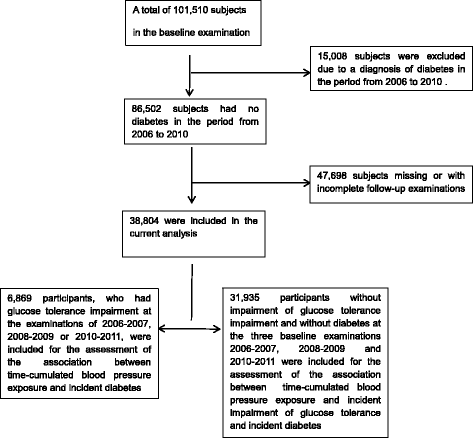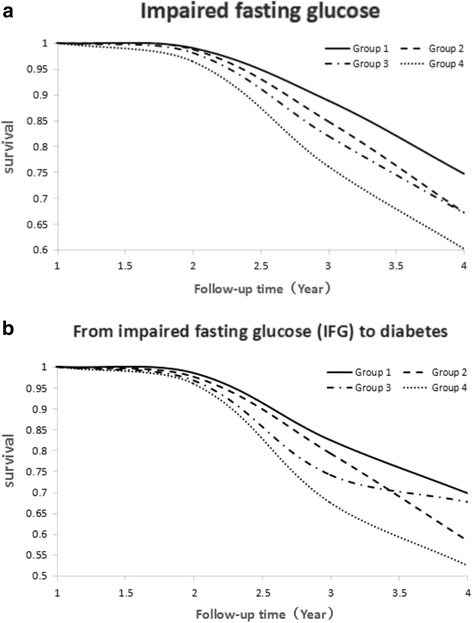Time-cumulated blood pressure exposure and incident impairment of glucose tolerance and diabetes mellitus
- PMID: 28464794
- PMCID: PMC5414153
- DOI: 10.1186/s12872-017-0537-y
Time-cumulated blood pressure exposure and incident impairment of glucose tolerance and diabetes mellitus
Abstract
Background: With the marked increase in the prevalence of diabetes mellitus, it was the purpose of our study to assess a potential association of time-cumulated exposure to systolic (CumSBP) and of diastolic blood pressure (CumDBP) with onset of impaired glucose tolerance and diabetes mellitus.
Methods: The prospective investigation included participants of the longitudinal Kailuan Study with three baseline examinations in 2006-2007, 2008-2009 and 2010-2011, re-examination in 2012-2013, and no diabetes mellitus at baseline. Cumulative blood pressure (BP) was calculated as cumBP = [(BP1 + BP2)/2 × time1-2] + [(BP2 + BP3)/2 × time2-3]. Based on cumSBP, the study population was stratified into four groups (cumSBP < 480mmHgxyear;n = 15,339; 480mmHgxyear ≤ cumSBP < 520mmHgxyear;n = 7214; 520mmHgxyears ≤ cumSBP < 560mmHgxyears;n = 5675; and cumSBP ≥ 560mmHgxyears;n = 10,576).
Results: After adjusting for demographic, anthropomorphic, biochemical, socioeconomic and lifestyle parameters and as compared with the first group, the second, third and fourth group showed a significantly higher incidence of diabetes (P-trend < 0.001;hazard ratio (HR);95% confidence interval (CI):1.28(1.08,1.51),1.54(1.29,1.84), and 2.33(1.98,2.73), respectively), higher incidence of impairment of glucose tolerance (P-trend < 0.001;HR;95% CI1.17(1.02,1.33), 1.43(1.25,1.64), and 2.09(1.85,2.37), respectively), and higher incidence of diabetes developing out of an impairment of glucose tolerance (P-trend < 0.001;HR;95% CI:1.22(0.97,1.54),1.47(1.16,1.86), and 2.01(1.62,2.50), respectively). An increase in cumSBP by 10 mmHg/year or an increase in cumDBP by 5 mmHg/year was associated with a hazard ratio of incident diabetes of 1.04 (95% CI:1.03,1.04) and 1.02(1.02,1.03), respectively, with a hazard ratio of incident impairment of glucose tolerance of 1.04(95% CI:1.03,1.04) and 1.03(95% CI:1.02,1.03), respectively, and with a hazard ratio of incident diabetes developing from impairment of glucose tolerance of 1.04(95% CI:1.03,1.04) and 1.03(95% CI:1.02,1.03), respectively.
Conclusions: Time-cumulated exposure to elevated blood pressure was significantly associated with an elevated incidence of impaired glucose tolerance and diabetes.
Keywords: Cumulative blood pressure exposure; Incident diabetes; Incident glucose tolerance impairment; Kailuan study.
Figures


Similar articles
-
Temporal relationship between triglyceride-glucose index and blood pressure and their joint cumulative effect on cardiovascular disease risk: a longitudinal cohort study.Cardiovasc Diabetol. 2023 Nov 28;22(1):332. doi: 10.1186/s12933-023-02058-1. Cardiovasc Diabetol. 2023. PMID: 38017521 Free PMC article.
-
Association of Insulin Resistance, Plasma Glucose Level, and Serum Insulin Level With Hypertension in a Population With Different Stages of Impaired Glucose Metabolism.J Am Heart Assoc. 2020 Apr 7;9(7):e015546. doi: 10.1161/JAHA.119.015546. Epub 2020 Mar 21. J Am Heart Assoc. 2020. PMID: 32200720 Free PMC article.
-
Different combinations of glucose tolerance and blood pressure status and incident cardiovascular disease and all-cause mortality events.J Hum Hypertens. 2017 Nov;31(11):744-749. doi: 10.1038/jhh.2017.49. Epub 2017 Jul 27. J Hum Hypertens. 2017. PMID: 28748918
-
Change in glucose intolerance status and risk of incident cardiovascular disease: Tehran Lipid and Glucose Study.Cardiovasc Diabetol. 2020 Mar 30;19(1):41. doi: 10.1186/s12933-020-01017-4. Cardiovasc Diabetol. 2020. PMID: 32228577 Free PMC article.
-
Control for multiple risk factors and incident heart failure and mortality in patients with diabetes mellitus: Insights from the Kailuan cohort study.Curr Probl Cardiol. 2024 Sep;49(9):102737. doi: 10.1016/j.cpcardiol.2024.102737. Epub 2024 Jun 27. Curr Probl Cardiol. 2024. PMID: 38944222 Review.
Cited by
-
The association between hypertension and other cardiovascular risk factors among non-diabetic Saudis adults-A cross sectional study.PLoS One. 2021 Feb 23;16(2):e0246568. doi: 10.1371/journal.pone.0246568. eCollection 2021. PLoS One. 2021. PMID: 33621259 Free PMC article.
-
Association of mean arterial pressure with 5-year risk of incident diabetes in Chinese adults:a secondary population-based cohort study.BMJ Open. 2022 Sep 19;12(9):e048194. doi: 10.1136/bmjopen-2020-048194. BMJ Open. 2022. PMID: 36123108 Free PMC article.
-
Effects of salt substitution on cumulative blood pressure: a secondary analysis of the SSaSS.Eur J Epidemiol. 2025 Mar;40(3):309-316. doi: 10.1007/s10654-025-01216-x. Epub 2025 Mar 27. Eur J Epidemiol. 2025. PMID: 40148710 Clinical Trial.
-
Association between Higher Blood Pressure and Risk of Diabetes Mellitus in Middle-Aged and Elderly Chinese Adults.Diabetes Metab J. 2020 Jun;44(3):436-445. doi: 10.4093/dmj.2019.0081. Epub 2019 Nov 14. Diabetes Metab J. 2020. PMID: 31769238 Free PMC article.
-
Association of cumulative monocyte to high-density lipoprotein ratio with the risk of type 2 diabetes: a prospective cohort study.Cardiovasc Diabetol. 2022 Dec 3;21(1):268. doi: 10.1186/s12933-022-01701-7. Cardiovasc Diabetol. 2022. PMID: 36463212 Free PMC article.
References
-
- Wang H, Naghavi M, Allen C, Barber RM, Bhutta ZA, Carter A, et al. Global, regional, and national life expectancy, all-cause mortality, and cause-specific mortality for 249 causes of death, 1980-2015: a systematic analysis for the Global Burden of Disease Study 2015. Lancet. 2016;388:1459–1544. doi: 10.1016/S0140-6736(16)31012-1. - DOI - PMC - PubMed
-
- Kassebaum NJ, Arora M, Barber RM, Bhutta ZA, Brown J, Carter A, et al. Global, regional, and national disability-adjusted life years (DALYs) for 315 diseases and injuries and healthy life expectancy (HALE) for 195 countries and territories, 1990-2015: a systematic analysis for the Global Burden of Diseases, Injuries, and Risk Factors (GBD) 2015 Study. Lancet. 2016;388:1603–1658. doi: 10.1016/S0140-6736(16)31460-X. - DOI - PMC - PubMed
-
- Forouzanfar MH, Afshin A, Alexander LT, Anderson HR, Bhutta ZA, Biryukov S, et al. Global, regional and national comparative risk assessment of 79 behavioural, environmental and occupational, and metabolic risks or clusters of risks in 195 countries: 1990-2015: a systematic analysis for the Global Burden of Disease Study 2015. Lancet. 2016;388:1659–724. - PMC - PubMed
MeSH terms
Substances
LinkOut - more resources
Full Text Sources
Other Literature Sources
Medical

